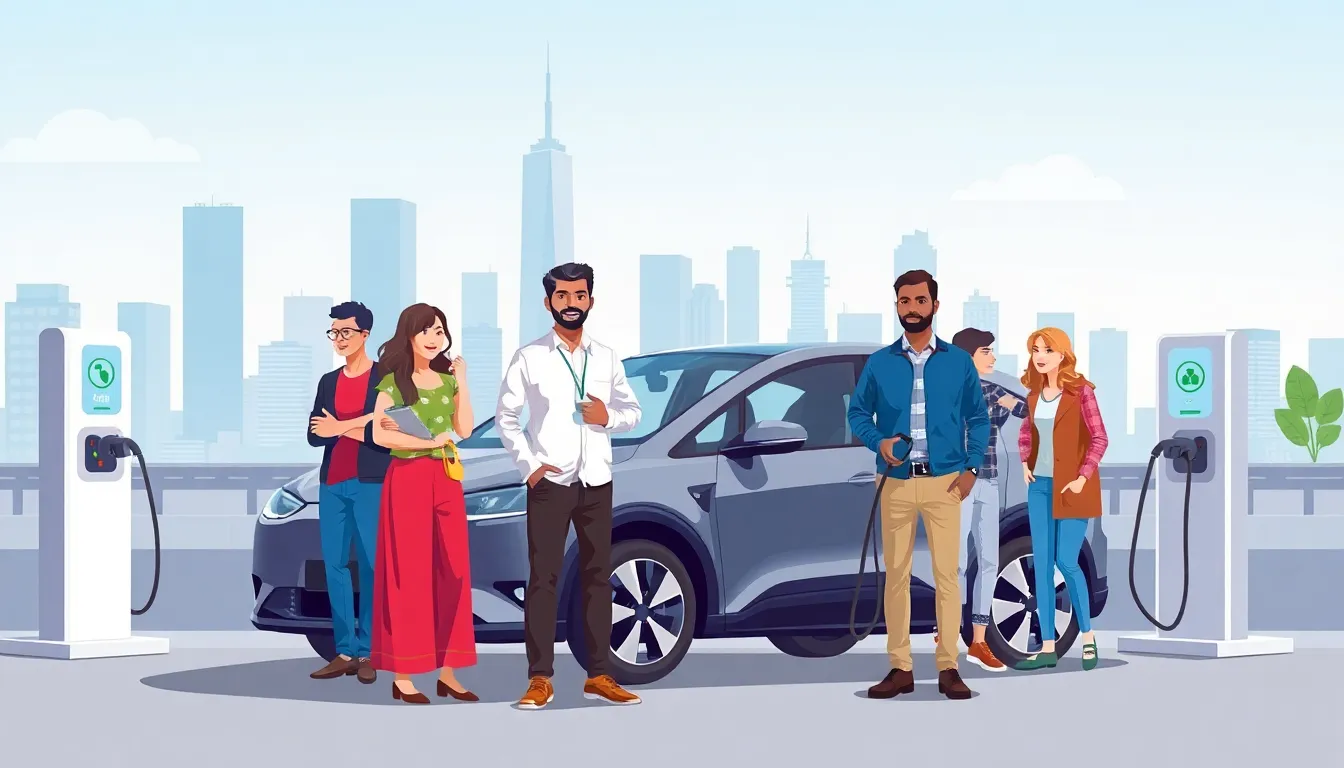Electric vehicles are zooming into the spotlight faster than a kid on a sugar rush. With the world racing towards sustainability, it’s no wonder that EV sales are skyrocketing. But what’s really driving this electric revolution? Spoiler alert: it’s not just the cool factor of silent rides and futuristic designs.
As consumers become more eco-conscious, the demand for electric vehicles is surging. Sales statistics reveal a fascinating shift in the automotive landscape, where gas-guzzlers are slowly but surely being replaced by sleek, battery-powered machines. Buckle up as we dive into the numbers that showcase how electric vehicles are not just a passing trend but a powerful force reshaping our roads and our planet.
Table of Contents
ToggleOverview of Electric Vehicle Sales
Electric vehicle sales show a remarkable upward trajectory, driven by consumer interest and regulatory support. The transformation in automotive preferences reflects a significant shift toward sustainable transport solutions.
Global Sales Trends
Global electric vehicle sales reached approximately 10 million units in 2022, representing a 55% increase from 2021. Key markets, such as China, lead these sales with over 6 million units sold. Europe follows closely with around 2.5 million units. Growth in electric vehicle market share reached 13% of total vehicle sales globally. Battery electric vehicles (BEVs) accounted for about 80% of electric vehicle sales, emphasizing the preference for fully electric models.
Regional Sales Insights
In North America, electric vehicle sales surpassed 800,000 units in 2022, marking a notable increase. The United States accounted for more than 70% of this regional total. California remains the leading state, representing nearly 40% of all electric vehicle sales. Meanwhile, in Asia-Pacific, sales surged to 7 million units, driven primarily by the Chinese market’s rapid adoption. Europe’s regulatory frameworks facilitated a growth rate of 28% in sales across major countries like Germany, Norway, and the United Kingdom.
Factors Influencing Electric Vehicle Sales

Several key factors contribute to the rising electric vehicle sales. These factors include government policies and consumer preferences, which drive the shift toward sustainable transportation.
Government Policies and Incentives
Government policies play a crucial role in promoting electric vehicle adoption. Incentives such as tax credits and rebates lower the upfront costs for consumers. Regulations aimed at reducing carbon emissions compel auto manufacturers to accelerate EV development. Various countries, including those in Europe and North America, implement stricter emissions standards, further encouraging the shift from traditional vehicles. In 2022, supportive legislation significantly contributed to the sale of over 10 million EV units globally, increasing primarily in countries with robust policies.
Consumer Preferences and Perceptions
Consumer preferences influence electric vehicle market dynamics significantly. Growing eco-consciousness leads many consumers to prioritize sustainability in their purchasing decisions. Increasing concerns about fossil fuel dependence drive interest in electric vehicles. Many potential buyers view EVs as innovative and modern, enhancing their appeal. Studies show that features like range, charging infrastructure, and performance heavily impact consumer choices. The robust sales increase is evident as approximately 80% of global EV sales in 2022 were battery electric vehicles, reflecting strong consumer preference for fully electric models.
Key Electric Vehicle Models in 2023
Electric vehicles continue to attract interest in 2023, with several models leading sales figures. Continued market expansion reflects evolving consumer preferences and advances in technology.
Sales Performance of Popular Models
Tesla remains a dominant player in the electric vehicle market. The Model Y, with impressive sales numbers topping 1 million units in 2022, leads the pack. Following closely, the Model 3 recorded over 300,000 units sold, further solidifying Tesla’s position. Other notable models include the Ford Mustang Mach-E, which achieved sales of approximately 40,000 units, and the Hyundai Ioniq 5, with around 30,000 units moved. These figures demonstrate a clear consumer desire for high-performance electric vehicles, driving sales trends forward.
Emerging Brands and Technologies
Emerging brands are reshaping the electric vehicle landscape. Rivian, for example, introduced the R1T and R1S, garnering attention and amassing over 20,000 pre-orders since launch. Additionally, Lucid Motors debuted the Lucid Air, attracting luxury consumers and selling approximately 7,000 units in 2022. Technological advancements play a critical role, with features like advanced battery technologies and autonomous driving capabilities making significant impacts. Startups like Fisker and Canoo are also entering the market, focusing on unique designs and eco-friendly materials, highlighting the industry’s shift toward innovation and sustainability.
Future Projections for Electric Vehicle Sales
Electric vehicle sales are anticipated to continue rising significantly in the coming years. Experts predict the global EV market could exceed 30 million units annually by 2030, largely driven by enhanced technology and greater infrastructure investment.
Market Growth Forecasts
Research indicates a compound annual growth rate of 22% for electric vehicle sales through 2030. China remains a leading market, with projections suggesting it could sell over 20 million EVs per year. The European market is set to expand considerably, bolstered by regulatory measures and ambitious emission targets. In North America, analysts expect the U.S. market to double its sales by 2025, reflecting a strong push toward electric mobility solutions. These figures underscore the rapidly evolving landscape of the automotive industry.
Challenges and Opportunities
While opportunities abound, challenges persist in the electric vehicle market. Limited charging infrastructure can hinder consumer adoption in various regions. Manufacturers face supply chain disruptions, particularly in sourcing critical battery materials like lithium. Addressing these challenges may require collaborative efforts among industry stakeholders. On the other hand, advancements in battery technology present opportunities for improved range and reduced costs. Emerging startups are fostering innovation alongside established manufacturers, enhancing market competitiveness. Sustainability initiatives also encourage consumers to embrace electric vehicles, further driving sales growth.
The electric vehicle market is undergoing a remarkable transformation fueled by consumer demand and supportive government policies. With significant sales growth and evolving consumer preferences, the shift toward sustainable transportation is clear. As technology advances and infrastructure improves, the future of electric vehicles looks promising.
Anticipated sales figures suggest a continued upward trajectory, with projections indicating over 30 million units sold annually by 2030. While challenges like charging infrastructure and material sourcing remain, the industry’s commitment to innovation and sustainability is driving change. As more consumers embrace electric vehicles, the automotive landscape will continue to evolve, marking a significant step toward a greener future.





